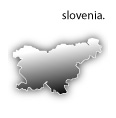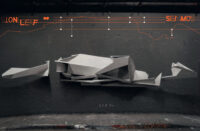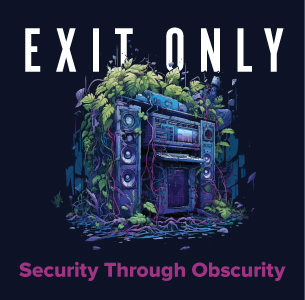
>>> Key
::..:::…..:..::….:::::..:::..:::::::……:::…::.:::….::::..:..:::…::…….::::
 :: Alan Abrahams’ second full-length Version is his debut on Berlin’s Scape label. On “Ebb and Flow” and throughout he warms us with urban rhythms waxed in undertones of minimal jungle beats. These repetitive, precise beats lay the groundwork for simplistic layers being built like Legos revealing certain slices that are peeled back and mined delicately, adding, extracting, like a fine gourmet. There are hints of dub and Jamaican vibes and even a shy nod to the resurgence of acid on “All Eject.” Portable’s sound sort of steals and reinvents the whole ( r )evolving lounge sound scene, but does right by making the late night listening experience something that is not only retrofit for today’s standards, but makes something quite heady remaining upbeat by design. By the way, the wig mannequin cover art is understated and brilliant, hinting at the highlights of the dusty 70s.
:: Alan Abrahams’ second full-length Version is his debut on Berlin’s Scape label. On “Ebb and Flow” and throughout he warms us with urban rhythms waxed in undertones of minimal jungle beats. These repetitive, precise beats lay the groundwork for simplistic layers being built like Legos revealing certain slices that are peeled back and mined delicately, adding, extracting, like a fine gourmet. There are hints of dub and Jamaican vibes and even a shy nod to the resurgence of acid on “All Eject.” Portable’s sound sort of steals and reinvents the whole ( r )evolving lounge sound scene, but does right by making the late night listening experience something that is not only retrofit for today’s standards, but makes something quite heady remaining upbeat by design. By the way, the wig mannequin cover art is understated and brilliant, hinting at the highlights of the dusty 70s.
::..:::…..:..::….:::::..:::..:::::::……:::…::.:::….::::..:..:::…::…….::::
 :: The pairing of Daniel Nieto and Pier Bucci on recordings made in their home of Santiago de Chile, brings together two extremely talented house DJ types whose fusion of Latin flavors make Eco a smooth dream. What makes the imagery so vibrant and dynamic is their use of timing, and odd, little sound effects that are both intricately crunchy and yet bubble-dubby (say that five times fast). It’s like your on some futuristic wild kingdom adventure hosted by the Teletubbies, but the Technicolor is tinged with shades of ochre and sunshine orange. With mastering by Stefan Betke the cast hue has an inverted dub basic built-in, though he restrains from making it his “sound” smartly avoiding the Stock, Aiken, and Waterman loss-of-self thang. There are subtle dead zones here though you are almost always moving to it, and when the radiance dies down it’s with a bevy of quirky blurts and hissing gases. What’s most evocative of the record is its inherent sense of animated humor, like a battery-dulling Speak n’ Spell on acid. Yeah, that’s it!
:: The pairing of Daniel Nieto and Pier Bucci on recordings made in their home of Santiago de Chile, brings together two extremely talented house DJ types whose fusion of Latin flavors make Eco a smooth dream. What makes the imagery so vibrant and dynamic is their use of timing, and odd, little sound effects that are both intricately crunchy and yet bubble-dubby (say that five times fast). It’s like your on some futuristic wild kingdom adventure hosted by the Teletubbies, but the Technicolor is tinged with shades of ochre and sunshine orange. With mastering by Stefan Betke the cast hue has an inverted dub basic built-in, though he restrains from making it his “sound” smartly avoiding the Stock, Aiken, and Waterman loss-of-self thang. There are subtle dead zones here though you are almost always moving to it, and when the radiance dies down it’s with a bevy of quirky blurts and hissing gases. What’s most evocative of the record is its inherent sense of animated humor, like a battery-dulling Speak n’ Spell on acid. Yeah, that’s it!
::..:::…..:..::….:::::..:::..:::::::……:::…::.:::….::::..:..:::…::…….::::
 :: How many times a disc shall be spun until one is able to say something that could validate its general objectives without restating the obvious. Brilliant! The problem was getting my fingers on to the keyboard for at least fifteen minutes. Uwe Schmidt in the form of Atom ™ compiles a collection of dance floor-ready classic sounding unknowns sequenced in chronological order from Phresh Phantasy’s rump rockin’ “Come on Acid” (1988) to Takeshi Onda’s wide n’ warehousy “Lock It” (2003). The latter sounding as fresh as the former and all in between are like magical moving dots moving in space connected by their sheer sweat and logic. Atom Heart’s own “Little Grey Box” (1992) reminds me of the era of “da bass” and recycles the general overdubbing of funky psychedelia to make any liquid crystal display unit run sideways. The stand-out, iconic track in this collection is the paced “Acid On” by Phreak. This 1991 gem just slowly twists with its repetitively whispered acid speak. Its chill-out, 5AM departure music with a plan, building in layers like a mile high wedding cake about to explode with an elfin porn star built-in. Microsmiles’ entry, the deep, lowbrow “Drugs Are Right” (1999) is anything but six years ago. Though, unlike pop music, most of this acid collection is meant for more of a prolonged bit of pleasure, not for speed culture ingestion. So, as some soulster’s once crooned, “take your time, do it right…”
:: How many times a disc shall be spun until one is able to say something that could validate its general objectives without restating the obvious. Brilliant! The problem was getting my fingers on to the keyboard for at least fifteen minutes. Uwe Schmidt in the form of Atom ™ compiles a collection of dance floor-ready classic sounding unknowns sequenced in chronological order from Phresh Phantasy’s rump rockin’ “Come on Acid” (1988) to Takeshi Onda’s wide n’ warehousy “Lock It” (2003). The latter sounding as fresh as the former and all in between are like magical moving dots moving in space connected by their sheer sweat and logic. Atom Heart’s own “Little Grey Box” (1992) reminds me of the era of “da bass” and recycles the general overdubbing of funky psychedelia to make any liquid crystal display unit run sideways. The stand-out, iconic track in this collection is the paced “Acid On” by Phreak. This 1991 gem just slowly twists with its repetitively whispered acid speak. Its chill-out, 5AM departure music with a plan, building in layers like a mile high wedding cake about to explode with an elfin porn star built-in. Microsmiles’ entry, the deep, lowbrow “Drugs Are Right” (1999) is anything but six years ago. Though, unlike pop music, most of this acid collection is meant for more of a prolonged bit of pleasure, not for speed culture ingestion. So, as some soulster’s once crooned, “take your time, do it right…”
::..:::…..:..::….:::::..:::..:::::::……:::…::.:::….::::..:..:::…::…….::::
 :: The busy Martijn Tellinga took nearly an annum to develop the latest release for Spekk. Built into two tracks, the first, “Enzo” is made up of ten parts, where he is clearly scaling tonal values by stretching simplistic movements and other tiny motors. The frequencies, from low and vibrating to those high-pitched swoops that scale the air, are the base for what’s going on here. Ringing that stalks, glassy percussive fragments that enchant with swelling profundity and a way left-of-center awkwardness make this a formidable listen. Though, one listens to hear the incredible subtleties, the contained flies, and the ghostly rattling of shaken and stirred jars. A ping-pong match delights as if it is being warped with a light saber. Other field recordings find their way in and out of Enzo as it is something of a sutured collage of found sound. Further contorts and expands with drone, sine waves and abstract percussion. Something of a soundtrack lullaby for baby spiders and latent Miss Pac Man fanatics this curious piece is simultaneously alert and opaque.
:: The busy Martijn Tellinga took nearly an annum to develop the latest release for Spekk. Built into two tracks, the first, “Enzo” is made up of ten parts, where he is clearly scaling tonal values by stretching simplistic movements and other tiny motors. The frequencies, from low and vibrating to those high-pitched swoops that scale the air, are the base for what’s going on here. Ringing that stalks, glassy percussive fragments that enchant with swelling profundity and a way left-of-center awkwardness make this a formidable listen. Though, one listens to hear the incredible subtleties, the contained flies, and the ghostly rattling of shaken and stirred jars. A ping-pong match delights as if it is being warped with a light saber. Other field recordings find their way in and out of Enzo as it is something of a sutured collage of found sound. Further contorts and expands with drone, sine waves and abstract percussion. Something of a soundtrack lullaby for baby spiders and latent Miss Pac Man fanatics this curious piece is simultaneously alert and opaque.
::..:::…..:..::….:::::..:::..:::::::……:::…::.:::….::::..:..:::…::…….::::
 :: Yes, the same Tom Heasley who amazed with his ambient tuba recordings just a few years ago is back with meditations using the didgeridoo, electronics and voice. Having visited Palm Springs for the first time earlier this year I can relate to the open desert as revealed through these three long passages. The rich depth of field drone on “Joshua Tree” is pure mind-meld, like a levitating field of raw sound. In the distance you hear the ghosts of wild coyotes howling in the faded striations of a latter day painting by J.M.W. Turner. The way this live recording (2003) develops is out of its vibrating centeredness, outwardly parting with rhythmic layers that are so subtle, like the first cool breeze after a blistering humid day. “Solitude” see-saws in slow motion, ripped from the cord in the sky and floating towards a seemingly endless landing guided by voices reminiscent of monk chant. While I find the dense simplicity of the instrument, the didgeridoo is more like the simple beauty of a flower that is hard not to get instantly, unlike the tuba, which has its own rich traditions. This depicts Heasley as a multifaceted instrumentalist who has created his own hi-fi/sci-fi without the trappings and kitsch –quite mystical and expansive.
:: Yes, the same Tom Heasley who amazed with his ambient tuba recordings just a few years ago is back with meditations using the didgeridoo, electronics and voice. Having visited Palm Springs for the first time earlier this year I can relate to the open desert as revealed through these three long passages. The rich depth of field drone on “Joshua Tree” is pure mind-meld, like a levitating field of raw sound. In the distance you hear the ghosts of wild coyotes howling in the faded striations of a latter day painting by J.M.W. Turner. The way this live recording (2003) develops is out of its vibrating centeredness, outwardly parting with rhythmic layers that are so subtle, like the first cool breeze after a blistering humid day. “Solitude” see-saws in slow motion, ripped from the cord in the sky and floating towards a seemingly endless landing guided by voices reminiscent of monk chant. While I find the dense simplicity of the instrument, the didgeridoo is more like the simple beauty of a flower that is hard not to get instantly, unlike the tuba, which has its own rich traditions. This depicts Heasley as a multifaceted instrumentalist who has created his own hi-fi/sci-fi without the trappings and kitsch –quite mystical and expansive.
::..:::…..:..::….:::::..:::..:::::::……:::…::.:::….::::..:..:::…::…….::::
 :: Slovenia’s RX:TX imprint moves ahead once again by releasing a multimedia disc project with sounds by Evgeniy Droomoff and Rostislav Rekuta which includes video, software (Digital Fibre made with MAX/MSP) and even an 8 page, finely illustrated, full-color print booklet of abstract oil paintings. The sounds are sparse and balance digital stutters and crackle with meandering flutes and other warped synthetic noise, like varietals from an unspoken BBC-TV classic time travel series. The surround mix is crystal clear, as if you were in the same room with the engineer who mastered it. Volokno has its clear dark (thinking) side, like a fountain of mercury bubbling away at a tenuous distance. The short-run twenty-four minute disc led me to watch the accompanying video work which was a lovely long-play animated slide show that melds one organic image into another and finally fades into lines and shifting shapes.
:: Slovenia’s RX:TX imprint moves ahead once again by releasing a multimedia disc project with sounds by Evgeniy Droomoff and Rostislav Rekuta which includes video, software (Digital Fibre made with MAX/MSP) and even an 8 page, finely illustrated, full-color print booklet of abstract oil paintings. The sounds are sparse and balance digital stutters and crackle with meandering flutes and other warped synthetic noise, like varietals from an unspoken BBC-TV classic time travel series. The surround mix is crystal clear, as if you were in the same room with the engineer who mastered it. Volokno has its clear dark (thinking) side, like a fountain of mercury bubbling away at a tenuous distance. The short-run twenty-four minute disc led me to watch the accompanying video work which was a lovely long-play animated slide show that melds one organic image into another and finally fades into lines and shifting shapes.
::..:::…..:..::….:::::..:::..:::::::……:::…::.:::….::::..:..:::…::…….::::
 :: After a throng of releases over the last handful and a half of years comes Kid 606’s balancing act and it’s called Resilience. Five years in the making, the overall impact is more like a finely tuned opus of miscellaneous rather than some of his usual fare, often seeming a bit too rooted in the here and now. This can be immediately heard and reflected in the overtones of the opening title “Done with the Scene.” ‘Nuff said, you think? Think again. Miguel Depedro, as he’s known to his homies, and this record is dedicated to his mom after all, kind of blends the best of his Mille Plateaux releases with a plausible punch of pop, all the while having the flavor of something seeded in 70’s Brit rock ala Queen and the Who. Woven in are his usual flare for adding quirky hooks like the Jamaican rhythms of “Banana Peel” and “Phoenix Riddim” which, along with a few other tracks appearing here was originally released on other recordings on Souljazz and Audraglint Recordings. Gone here is the pastiche of basic urban cut-up hip hop, replaced with his more experimental inclinations to make a sound that flows with more of a flatter and broader leaning. Tracks like “Xmas Funk” may need vocals, it feels a bit naked and lacks a real inherent soul, more filler than flier. Elsewhere throughout Resilience you can hear the deadened influences of everything from the vapid Electroclash scene to the dark chasm of Cabaret Voltaire, especially on the pokey “Sugarcoated.” Influences aside, the heart of this recording lies in its diversity of style and capability for creating something completely uncharacterizable and genre-less. It’s not quite late night listening, and yet not music that you can dance to, but it makes some overtures into the world of the soundtrack –as if something (like the film, or the vocals) is missing. “Short Road Down” is awfully shy and resistant, it kind of meanders as the tempo flashes from fore to background over and over, while staying a paved course throughout. Saving the best for last, the Kid concludes with a more ambient vibe on “Audition” ending the disc blissfully, like a faded memory in a recital hall. Back to start.
:: After a throng of releases over the last handful and a half of years comes Kid 606’s balancing act and it’s called Resilience. Five years in the making, the overall impact is more like a finely tuned opus of miscellaneous rather than some of his usual fare, often seeming a bit too rooted in the here and now. This can be immediately heard and reflected in the overtones of the opening title “Done with the Scene.” ‘Nuff said, you think? Think again. Miguel Depedro, as he’s known to his homies, and this record is dedicated to his mom after all, kind of blends the best of his Mille Plateaux releases with a plausible punch of pop, all the while having the flavor of something seeded in 70’s Brit rock ala Queen and the Who. Woven in are his usual flare for adding quirky hooks like the Jamaican rhythms of “Banana Peel” and “Phoenix Riddim” which, along with a few other tracks appearing here was originally released on other recordings on Souljazz and Audraglint Recordings. Gone here is the pastiche of basic urban cut-up hip hop, replaced with his more experimental inclinations to make a sound that flows with more of a flatter and broader leaning. Tracks like “Xmas Funk” may need vocals, it feels a bit naked and lacks a real inherent soul, more filler than flier. Elsewhere throughout Resilience you can hear the deadened influences of everything from the vapid Electroclash scene to the dark chasm of Cabaret Voltaire, especially on the pokey “Sugarcoated.” Influences aside, the heart of this recording lies in its diversity of style and capability for creating something completely uncharacterizable and genre-less. It’s not quite late night listening, and yet not music that you can dance to, but it makes some overtures into the world of the soundtrack –as if something (like the film, or the vocals) is missing. “Short Road Down” is awfully shy and resistant, it kind of meanders as the tempo flashes from fore to background over and over, while staying a paved course throughout. Saving the best for last, the Kid concludes with a more ambient vibe on “Audition” ending the disc blissfully, like a faded memory in a recital hall. Back to start.
::..:::…..:..::….:::::..:::..:::::::……:::…::.:::….::::..:..:::…::…….::::
 :: With a batch of sound pieces collected from Y2K to the present, Meri von KleinSmid jolts the casual listener with concoctions that seem like the equivalent of b-movie soundtracks and toy instruments, alongside a whole lot of clever gestural manipulations. Equally blending field recordings with stuttering voice cuts, tracks like “Five-Word Farrago” play roulette with vowels while manipulating basic chord structures with radio waves. From fidgety to ambient, von KleinSmid develops short themes smartly using tones, drones or other left-of-center noises. Her “Idle Chatter” with its simultaneous talking tones, is the case in point, a humorous take on most interactive conversation at the crux of our Internet-laden voiceless culture. The metallic low-rise percussion of “The Rats in the Walls” plays out like an electronic chamber of wind. While meditative, it does question your immediately surrounding space, as a distorted absence of tactile presence. At about thirteen minutes, the track is an obvious stand-alone work that is evocative of most contemporary installation soundtracks. The subject looms thickly in the distance, through layers of translucence. The only drawback on Ex Vivo is the awkward, Gorey graphic layout.
:: With a batch of sound pieces collected from Y2K to the present, Meri von KleinSmid jolts the casual listener with concoctions that seem like the equivalent of b-movie soundtracks and toy instruments, alongside a whole lot of clever gestural manipulations. Equally blending field recordings with stuttering voice cuts, tracks like “Five-Word Farrago” play roulette with vowels while manipulating basic chord structures with radio waves. From fidgety to ambient, von KleinSmid develops short themes smartly using tones, drones or other left-of-center noises. Her “Idle Chatter” with its simultaneous talking tones, is the case in point, a humorous take on most interactive conversation at the crux of our Internet-laden voiceless culture. The metallic low-rise percussion of “The Rats in the Walls” plays out like an electronic chamber of wind. While meditative, it does question your immediately surrounding space, as a distorted absence of tactile presence. At about thirteen minutes, the track is an obvious stand-alone work that is evocative of most contemporary installation soundtracks. The subject looms thickly in the distance, through layers of translucence. The only drawback on Ex Vivo is the awkward, Gorey graphic layout.
::..:::…..:..::….:::::..:::..:::::::……:::…::.:::….::::..:..:::…::…….::::
 :: Let me just start by saying I (normally) love EPs! They always give you an opportunity to sample a bit of someone’s sound, and usually they are a prime example, because they include a consolidated small batch of tracks that highlight a concept rather than dwell on one. Herein Leeds-based M. Robson proves that he can concoct some obliquely fractured techno that resigns itself from the dance floor on “Hawthorn.” The work is for those in line with Squarepusher, with its tinny percussion bits and happenstance orchestral vortexes. Though, EP Charge is a bit too introspective and self-conscious. I just want some breakout beats or some fun jam to thrill me, but instead there is a more serious tone, but not dark enough to grab my focus. That is, until the final track, the very short and engaging elegy “Proles Are Still Tired” with its piano-scape and remote ambiance, it could launch something quite magnificent, but only leaves you wanting. At just over two minutes, it was worth the wait, but at the same time, this bit of random can cut to the chase for me next time. I want my dessert first!
:: Let me just start by saying I (normally) love EPs! They always give you an opportunity to sample a bit of someone’s sound, and usually they are a prime example, because they include a consolidated small batch of tracks that highlight a concept rather than dwell on one. Herein Leeds-based M. Robson proves that he can concoct some obliquely fractured techno that resigns itself from the dance floor on “Hawthorn.” The work is for those in line with Squarepusher, with its tinny percussion bits and happenstance orchestral vortexes. Though, EP Charge is a bit too introspective and self-conscious. I just want some breakout beats or some fun jam to thrill me, but instead there is a more serious tone, but not dark enough to grab my focus. That is, until the final track, the very short and engaging elegy “Proles Are Still Tired” with its piano-scape and remote ambiance, it could launch something quite magnificent, but only leaves you wanting. At just over two minutes, it was worth the wait, but at the same time, this bit of random can cut to the chase for me next time. I want my dessert first!
::..:::…..:..::….:::::..:::..:::::::……:::…::.:::….::::..:..:::…::…….::::
 :: Sala Santa Cecilia is a live recording, like a shower of fire, made in Rome (’04). Immediate, frenzied blur of friction curtailed and contained by a fervent underscore of sacred solitude played in the bellows of rhythmic quietude. For a moment halfway in it sounds like an open mic to a kitchen sink as its being repaired, but soon all that chaos is a saturated wash of scrap ambience. Through some basic shaky jitters and hot wires something bobbles to break free, the percussion is stabilized and the background of synthetics builds brilliantly like a Polynesian sunrise. The aerated sonics travel side to side as the piercing feedback-like singe so familiar to the Fennesz style is subdued here, leaving equal play room space. It’s a great combination, a brief experiment that literally tickles your inner ear. The ending bleeds a meditative fusion of passion and release.
:: Sala Santa Cecilia is a live recording, like a shower of fire, made in Rome (’04). Immediate, frenzied blur of friction curtailed and contained by a fervent underscore of sacred solitude played in the bellows of rhythmic quietude. For a moment halfway in it sounds like an open mic to a kitchen sink as its being repaired, but soon all that chaos is a saturated wash of scrap ambience. Through some basic shaky jitters and hot wires something bobbles to break free, the percussion is stabilized and the background of synthetics builds brilliantly like a Polynesian sunrise. The aerated sonics travel side to side as the piercing feedback-like singe so familiar to the Fennesz style is subdued here, leaving equal play room space. It’s a great combination, a brief experiment that literally tickles your inner ear. The ending bleeds a meditative fusion of passion and release.
::..:::…..:..::….:::::..:::..:::::::……:::…::.:::….::::..:..:::…::…….::::
Essential Links ::
::..:::…..:..::….:::::..:::..:::::::……:::…::.:::….::::..:..:::…::…….::::
Read more Microview’s ::
11, 10, 9, 8, 7, 6, 5, 4, 3, 2, 1
::..:::…..:..::….:::::..:::..:::::::……:::…::.:::….::::..:..:::…::…….::::





















